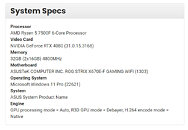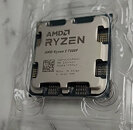- Joined
- Oct 9, 2007
- Messages
- 47,871 (7.38/day)
- Location
- Dublin, Ireland
| System Name | RBMK-1000 |
|---|---|
| Processor | AMD Ryzen 7 5700G |
| Motherboard | Gigabyte B550 AORUS Elite V2 |
| Cooling | DeepCool Gammax L240 V2 |
| Memory | 2x 16GB DDR4-3200 |
| Video Card(s) | Galax RTX 4070 Ti EX |
| Storage | Samsung 990 1TB |
| Display(s) | BenQ 1440p 60 Hz 27-inch |
| Case | Corsair Carbide 100R |
| Audio Device(s) | ASUS SupremeFX S1220A |
| Power Supply | Cooler Master MWE Gold 650W |
| Mouse | ASUS ROG Strix Impact |
| Keyboard | Gamdias Hermes E2 |
| Software | Windows 11 Pro |
A screenshot from Puget Systems benchmark database reveals a new upcoming desktop processor model by AMD, the Ryzen 5 7500F. The screenshot details the 7500F as a 6-core processor, and the machine features an ASUS ROG Strix X670E-F Gaming motherboard, along with an RTX 4080 graphics card. At this point it's hard to tell what the "F" brand extension means in AMD nomenclature. On Intel, it denotes a lack of integrated graphics.
There are two possible theories on what the 7500F could be. One holds that it's a down-rated "Raphael" MCM with a disabled iGPU; while the other holds that it could be based on the 4 nm Phoenix-2 monolithic silicon. Detailed in an older article, the Phoenix-2 is a 137 mm² monolithic silicon that physically features no more than 6 "Zen 4" CPU cores, and an iGPU with just 4 RDNA 3 compute units, besides I/O that's identical to that of the regular 178 mm² 8-core/12-CU Phoenix silicon. Phoenix-2 on AM5 might just end up with a lower bill of materials than a single-CCD "Raphael" MCM.
Update 06:13 UTC: A Korean retailer has posted the first picture of the Ryzen 5 7500F in the flesh. They claim a street price of around $170-180 (KRW equivalent), and availability slated for July 7.


View at TechPowerUp Main Site | Source
There are two possible theories on what the 7500F could be. One holds that it's a down-rated "Raphael" MCM with a disabled iGPU; while the other holds that it could be based on the 4 nm Phoenix-2 monolithic silicon. Detailed in an older article, the Phoenix-2 is a 137 mm² monolithic silicon that physically features no more than 6 "Zen 4" CPU cores, and an iGPU with just 4 RDNA 3 compute units, besides I/O that's identical to that of the regular 178 mm² 8-core/12-CU Phoenix silicon. Phoenix-2 on AM5 might just end up with a lower bill of materials than a single-CCD "Raphael" MCM.
Update 06:13 UTC: A Korean retailer has posted the first picture of the Ryzen 5 7500F in the flesh. They claim a street price of around $170-180 (KRW equivalent), and availability slated for July 7.


View at TechPowerUp Main Site | Source






